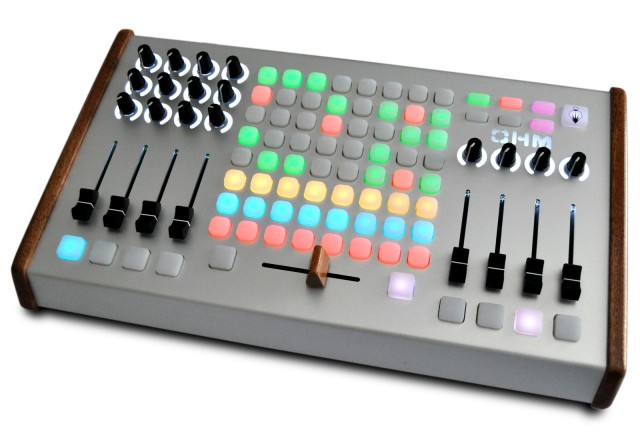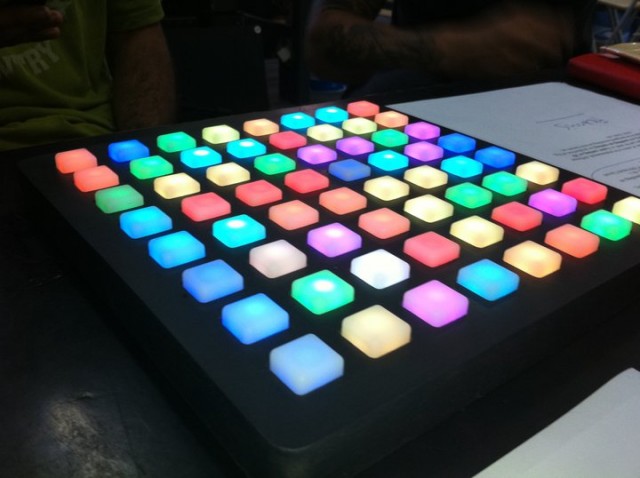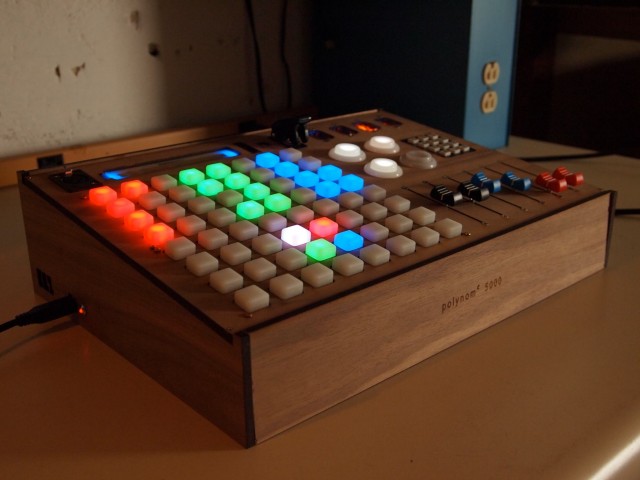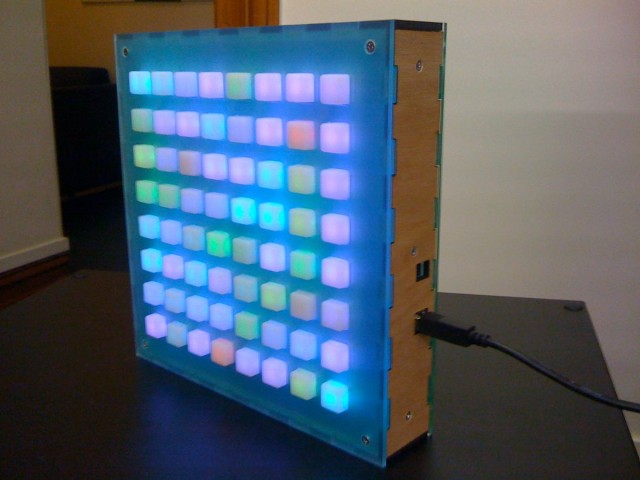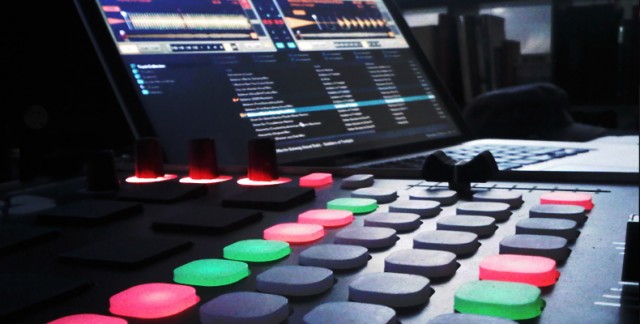Lovers of the grid for music control now get to reenact the scene in MGM’s The Wizard of Oz, stepping out of the world of black and white into one of color. The OhmRGB, the latest controller from Austin, Texas-based controller and custom hardware shop Livid Instruments, adds multicolor LEDs behind its array of controls.
We’ve already seen red, green, and yellow add color feedback on Novation’s Launchpad (and of course the APC line from Akai). The Livid piece bests Novation’s three colors with seven possibilities. For those who prefer their grids to come with knobs, faders, and crossfader, the OhmRGB has the same generous complement of controls that its (monochromatic) Ohm64 sibling does. It also has expansion ports for additional flexibility, plugs into USB connectivity and power without the need for drivers, and has extensive options for remapping lights, controls, and interaction, so it works dynamically not only with Ableton Live but any tool you like. Livid also does their woodwork and assembly in Austin, Texas – keeping the shop on-site was a wise business move, believe me.
In the top video, you can see artist Pailo do a quick demo; obviously, you could perform with this however you want. In the video below, the Livid gang explain a bit about how they’ve made the Ohm64 RGB work with Ableton Live:
This video is presented by Pailo and shows how you can use it with OhmModes, a sophisticated remote script for Ableton Live
Jay Smith from Livid has some other comments – and even those seven colors aren’t necessarily the limit:
Currently it supports 7 colors, we plan on adding more with a firmware update in the future. It has the same expansion jacks the Block [controller] has, we plan on making side cars for it later this year. Also we’ve added banking so you can save multiple mappings to the internal memory of the controller.
And here’s a video that shows why the expansion ports are cool:
Want one? Check it out at Livid Instruments:
http://lividinstruments.com/hardware_ohmrgb.php
US$699, available now direct or via your dealer.
More RGB Action!
While Livid doesn’t make hardware that can be technically qualified as open source, they have built a strong relationship with the DIY community. Their software patches, built in Max/MSP, are available under an open source license, and their hardware is well-suited to hacking and modification. And beyond the finished products themselves, they’ve got a full-blown DIY platform called Builder and have generally built a good relationship with DIYers through their shop and interaction with the community.
All of that is to say, there’s a lot happening with exploring what grid controllers can be as hardware hackers and musicians take matters into their own hands. Unlike the OhmRGB, you can’t easily go out and buy one of these at the moment, but it’s fantastic to see the rainbow (ahem) of control experimentation out there.
Thanks in particular to Mutis Mayfield, aka Mudo de Nacimiento, who helped remind us of some of the major RGB grid efforts to date. Mudo himself is working a project, seen in the image below.
Clarification/correction: Mudo adds some notes on that project:
I had to say that the project in the picture wasn’t mine, to be exact I’m part of the project as a free-lancer taking the task of community management and concept designer for the software implementation with third party softwares.
This project started as a revision for the Octinct from Jonathan, Owen and Jordan whit the aim to give a Octinct unit to some artist at Hangar.org over workshop over the Sonar(matica) 2009 (these workshops were free admitance) but it was evolving into a new project (with new design for the boards) which is the one from the picture.
We expect more information on that project soon.
I have to start out with the insanely-awesome Polynome 5000. It’s about the dreamiest color controller I can imagine, a one-off monome by capricorn one, aka Los Angeles-based monome musician and inventor Colin Mann. Colin describes it thusly:
After more hours than I’d like to admit, even if I actually knew how many, I’m done. I started this, believe it or not, before the APC40 was even announced, and at the time there weren’t many products out there like it. Now, obviously it would make more sense to just buy one of those products, nevertheless, where are you gonna get an RGB monome with a nixie tube display that takes OSC commands? Exactly.
FEATURES
RGB monome (64 buttons, 64 colors)
6 slide faders
1 infrared sensor
1 touch strip sensor
4 arcade buttons (internally lit)
1 toggle switch
4 digit nixie tube display
12 button keypad
xlr microphone pass through
6 port usb hub (powered)
4 external power jacks
1 12VDC power output source
Don’t miss Colin’s huge post on the topic; see also video below.
http://www.capricorn1.net/avr/polynome-5000/
Next up, another DIY project — from artist and hacker BIM0X, the Rainbow:
Presentation of my new MIDI controller : the Rainbow.
Soft touch buttons Monome like, each one has a RGB Led inside.
64 buttons, 7 colours available. Based on midibox (www.ucapps.de)Powered by PIC18F452. Completley independent, it doesn’t need a computer to work.
Midi and output via MIDI messages
Open source RGB grids?
Owen Vallis and Jordan Hochenbaum, aka FlipMu, have been working on their own open source project. It’s not just RGB – it’s also pressure-sensitive, a feature generally missing from these sorts of grid controllers, adding a whole new dimension of possible expression.
Owen shares some other comments, and walks us through yet more RGB and even pressure-sensitive projects:
The Livid stuff is always awesome I think. I’m all for more DIY or any open source projects. There have been a lot of RGB style button grids over the last several years, starting with the Octinct from Johnaton Guberman and Brad Hill ( <-- the original Arduinome Shield designer). The Octinct was finally made open source last year and is now being worked on by the guys at Hanger.org. There was also the RGB mini Monome by Grumpy Mike at the arduino forums (vimeo video), and also the Lumi from stanford which combined pressure and a touch screen using the spark fun RGB pads in a 4×8.
The Chronome is different (and has been taking so long) because it not only uses a Mega (hopefully allowing for expansion later), but also adds 64 independent pressure and RGB buttons. Trying to solve for noise on the ADC while lighting all 64 RGB leds was super hard to solve ….but it works now 🙂 woop woop. The other major thing is that the Chronome works natively with SerialOSC from monome, and still works the exact same as a regular monome. The only difference is the Chronome also accepts an RGB message, and send an additional pressure message. This means the Chronome should work with all existing monome apps.
The Chronome, based on the open-source Arduinome project also from FlipMu, is progressing nicely. You can track its progress – and even try your hand at building it yourself – on the FlipMu site and blog (hosted by createdigitalmusic):
http://flipmu.createdigitalmusic.com/blog/
http://flipmu.createdigitalmusic.com/work/chronome/ [beta, but with loads of files for your use if you’re brave]
Here are some of the projects Owen mentions:
The best resource I could find on the now-open-source Octinct project is on the monome forums:
Official Octinct Package Thread
It points at where to find the newly-released documentation, code, PCBs, and whatnot.
Also, there’s one further device that may be available commercially, though, for now, it remains mysterious. The Electrix Tweaker has specs similar to the OhmRGB, but we’re still waiting for it to ship, and have only the grainy image seen here.
So, there you have it – color is coming to grids in a big way. We’ll be watching the development of the OhmRGB, in particular, and it remains the full-color controller you can have right now. And we’ll watch these more experimental projects, too. It’s like a rainbow…
http://lividinstruments.com/hardware_ohmrgb.php
